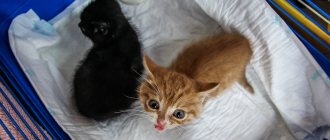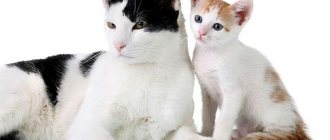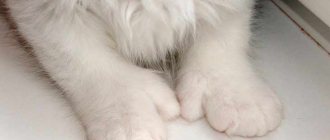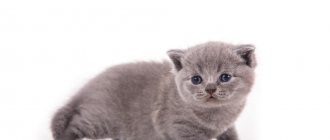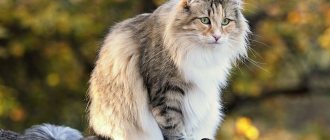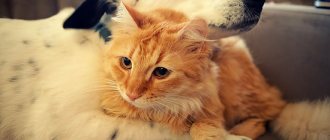Stages of a cat's life
According to scientists, a cat’s life goes through six age stages:
- Childhood (from birth to 6 months) is a stage of rapid growth and development until the onset of puberty.
- Youth (from 6 months to 2 years) – preparation for adulthood; growth continues, but its pace is decreasing.
- The prime of life (from 2 to 7 years) is the peak of physical and mental activity: the cat has strong bones, teeth and beautiful healthy fur.
- Maturity (from 7 to 11 years) – a slight decrease in activity.
- Old age (from 11 to 15 years) – gradual loss of vitality, which affects the condition of the coat, claws and teeth; occasionally health problems.
- Old age (over 15 years) – decreased activity, increased sleep duration, greater risk of disease.
Analogy of the life periods of people and cats
Representatives of the cat breed can go through six main stages during their lives, from birth to old age. Cats, like people, tend to behave differently at different ages.
For example, it is easier to train a small kitten to use a litter tray than an adult cat. As a pet grows and develops, its skills, habits, and character traits are formed.
If we make a comparison between a cat and a person, we can draw the following conclusions:
- in both cases the baby is a helpless creature, completely dependent on the mother;
A newborn kitten is completely dependent on its mother cat
- in childhood, all children learn about the world around them and acquire certain skills;
- in adolescence, the cat and the person are active, but have no experience;
- young people and cats are full of strength and energy;
- in adulthood, experience and skills come to them;
- being old people, they gradually lose activity and the acuity of their senses.
Infancy
The infancy period in kittens passes much faster than in humans, and lasts until about 1 month. This time is the most difficult for a kitten: he learns about the world around him and begins to walk.
The kittens that are born are completely helpless; they do not see or hear anything. 5 days after birth, their eyes begin to open slightly, and a week later hearing appears. In the second week of life, baby teeth erupt. Translated into human age, this period corresponds to the age of 5–9 months.
At one month, kittens can run and jump, which corresponds to the age of children of 1 year and 5 months.
A month old kitten behaves like a one and a half year old child
Childhood
Childhood begins in the second month and lasts up to six months. During these months, pet development occurs very quickly, and it is not easy to compare it with the corresponding human years. A three-month-old kitten can be comparable in intelligence to two-year-old children.
Kittens at 4 months are active, mobile, spend time playing and communicating with other kittens. They can distinguish “us” from “stranger”; they sharpen their claws, lick their fur, wash themselves and eat.
Their innate instincts help them in this, and they also learn from their mother’s example to take care of themselves. During the first year of its life, a cat goes through all the stages of growing up. By human standards, the end of childhood corresponds to 14 years.
A kitten ends its childhood period at six months
It is during this period of time, when the kitten is growing up, that you need to pay attention to the issues of raising your pet in order to catch it before it develops skills and habits that are undesirable for the owner. For example, you should teach the animal that it is forbidden to scratch furniture or go to the toilet where it wants.
Youth
A cat's adolescence begins at 7 months and ends when he is one year old. Although the kitten is still growing at this time, its growth rate is slowing down. Cats reach puberty.
During adolescence, the cat begins puberty
In long-haired breeds, the coat reaches its constant length. The animal gets used to the environment, to the available pets, and determines a distinct life routine for itself.
During adolescence and adolescence, you cannot treat a cat like a child, forgive its aggressiveness, minor dirty tricks such as leaving puddles. This will not go away on its own with age. Indeed, at this time, translated into human age, the cat becomes comparable to a teenager in adolescence, and significant changes are observed in his behavior and character.
Youth
A cat's youth ranges from 2 to 6 years. At this stage of life, the cat feels strong, he is tireless and dexterous.
The young cat is full of strength and dexterity
Youth (in humans it begins after 20 years) is the best time for a purebred pet to be able to participate in all kinds of exhibitions and competitions. This period is also ideal for conceiving healthy offspring.
Maturity
The cat's maturity period ranges from 7 to 10 years. For a person, these are years from 40 to 55.
Mature age occurs when the cat is over 7 years old
At such times, cats become calm, but sometimes they can play. Professional breeders of purebred animals that have reached adulthood stop breeding them.
Old age
Cats over 11 years of age, sometimes living to 20 years or more, are considered seniors. The venerable age of the animal does not at all indicate its imminent death. A cat's longevity depends on its health and conditions of detention.
A cat becomes elderly after 11 years
Pets, for example, often exceed the life span of 16 years, and street cats live no longer than 10 years. With good care, cats feel great in old age.
The family pet, the Persian cat Kuzya, delighted those around him with his presence for 14 years and lived to an old age. Throughout his life he was always active and inquisitive.
Video: caring for an old cat
Physiological signs of a cat's age
It happens that an animal ends up with owners who are not aware of how old it is - for example, from a shelter or straight from the street. In such cases, veterinarians pay attention to the condition of the animal’s teeth to determine its approximate age:
- At 1 month the kitten has all its milk teeth.
- By 6 months they are completely replaced by native ones.
- By the middle of the second year of life, the central middle incisors are slightly worn down.
- By the age of two and a half, the lower middle incisors begin to wear off.
- At three and a half years, this also happens to the central teeth of the upper jaw.
- In another year - with the average ones.
- By the age of five, the fangs begin to suffer.
- By six – the outermost upper incisors.
- By nine, all the teeth in the lower jaw have been ground down.
- And by ten - the top one.
- By twelve, the central incisors may begin to fall out.
- Some cats lose most of their teeth by age fifteen.
These parameters are highly dependent on breed, heredity and health. You should also take into account how and what the animal eats, what conditions it lives in, and whether it receives vitamin and mineral supplements that help protect teeth from age-related changes.
How to calculate how old a cat is based on signs of puberty
Cat puberty is considered the simplest answer to how to determine the age of a cat. Mostly it begins at the age of 7-9 months, and, having sheltered a purr in the house, you just need to wait for this moment. But, in some cases, cats mature a couple of months earlier, therefore, this method is relative.
A cat's puberty is indicated by the specific smell of urine when trying to mark its personal territory. Cats become especially affectionate at this time and meow loudly. Once heat begins, they are constantly surrounded by cats.
Age comparison principles
There is an opinion that in order to calculate the age of a cat by human standards, it is enough to multiply it by seven. In fact, this approach is only valid for animals between three and ten years of age.
They grow up and grow old at a completely different pace than humans.
It is necessary to take into account the principles of recalculation:
- There is no calculation formula for cats under three years of age.
- A three-year-old animal reaches approximately the same degree of development as a person at 25-30 years old.
- From three to five years, this figure increases by 7 every year.
- From five to twelve years – by 4.
- After twelve years, each year is counted as 3.
How to determine a cat's age by weight
A cat's weight will not accurately determine its age and is the least accurate way. It largely depends on the gender and breed of the cat, and physical characteristics. Only very approximate figures can be taken into account here.
| Age of the cat | Weight |
| 1 month | 500-750 g |
| 2 months | 1-1.5 kg |
| 3 months | 1.7-2.3 kg |
| 4 months | 2.5-3.6 kg |
| 5 months | 3.1-4.2 kg |
| 6 months | 3.5-4.8 kg |
So, at the age of 6 months, according to this table, I weighed a little less than I should, as if I was a whole month younger. Therefore, if you are not sure of the methods to help determine the age of the animal, you can take your pet to a veterinarian, who will help answer the question of how old the cat is and give recommendations regarding the necessary care.
Lifespan of cats and its extension
There is a pattern in nature: the smaller the animals, the shorter their life span. Cats are an exception in this regard - they live relatively long for their size. They usually manage to live to be fifteen to twenty years old.
The oldest one, according to the Guinness Book of Records, is 38 years old (about 145 years old by human standards).
Among the factors on which the longevity of these animals depends are the following:
- Breed. For example, Snowshoes live on average 11 years, American Bobtails - 13, Scots - 14, Persians, Sphynxes and British - 15, Maine Coons and Kuril Bobtails - 16, Tiffany - 18. Siamese, Thais and American Shorthairs, which often live up to 20 years.
- Lifestyle. Movement is a very important need for an animal. Passive pastime shortens his life.
- Nutrition. An unbalanced diet negatively affects the general condition of the body. Both a deficiency and an excess of certain substances have a negative impact.
- Sexual activity. Unsterilized cats and cats must have the opportunity to realize their sexual instincts - otherwise the hormonal balance in the body is disrupted.
- Psychological condition. Stress and emotional stress lead to neuroses and shorten life.
Based on this information, several simple principles of longevity can be identified: a balanced diet, an active lifestyle, a psychologically safe environment, sterilization if necessary and timely visits to the veterinarian.
According to research, the aging process in cats begins after about four years of age. Despite this, many animals feel great even in old age and remain active.
However, sooner or later, old age takes its toll, and owners begin to be interested in the issue of extending the life of their pet.
It is possible to slow down this process if you follow seven simple recommendations:
- Do not feed the animal “from the table”, use specialized complex feed of the highest quality. Give preference to poultry and lean beef. If the cat is accustomed to homemade food, the transition should be smooth.
- Do not give milk: it is contraindicated in adult cats because they do not produce the enzyme to digest it.
- Organize a proper diet, especially if the animal is prone to obesity. Avoid overeating.
- Provide the cat with conditions for active play and take walks outside.
- Maintain hygiene: periodically clean ears, eyes and teeth, comb out fur.
- Carry out prevention against parasites using anthelmintic drugs and anti-ectoparasites.
- Visit the veterinarian and get the necessary vaccinations.
How to extend the life of cats
During the growth and development of an animal, it is accompanied by various ailments. As a rule, they are all associated with poor nutrition, a sedentary lifestyle, and a lack of vitamin and mineral components, which leads to negative consequences and a reduction in the life expectancy of pets.
Interesting information! According to scientists, the natural processes of aging in cats begin already in the fifth year of life, which is associated with a weakening of the functions of the immune system and a reduction in the intake of antioxidants.
Based on this definition, there are ways that can extend the life of cats. Such decisions should include:
- Pets should be fed exclusively with healthy and nutritious food products, as well as premium store-bought food.
- Get vaccinations recommended by specialists in a timely manner, and also visit your veterinarian regularly.
- A pet should be in constant motion, regularly visiting the street.
- Regularly prevent infection of domestic animals with ectoparasites and worms.
- Constantly monitor the condition of the skin, coat, as well as the eyes, ears and teeth of your pet.
- If the animal is not intended for breeding work, then it must be castrated or sterilized in a timely manner.
- After six months of life, large amounts of milk should be excluded from the cat’s diet, as this promotes the production of lactase.
- The diet should include a sufficient amount of raw meat, but only high-quality meat in the form of lean beef or chilled poultry.
- Do not practice sudden transitions from one type of nutrition to another.
- Do not allow your pet to constantly overeat, otherwise this can lead to obesity and further heart problems, constipation and diabetes.
Organizing proper nutrition for a pet using only high-quality food or ready-made diets, along with care and love for the pet, are the fundamental factors that have a major impact on the life expectancy of cats.
At specialized retail outlets you can purchase factory-made, ready-made food rations that are balanced in terms of vitamins and minerals. There are brands of diets that have proven themselves well and are very popular. These are diets such as ProPlan, Brit Premium and Brit Care, Royal Canin, Hills and others. In any case, you can get comprehensive information from the sellers of this product.
When feeding your pet with natural foods, you should not feed certain foods from the table, such as fried, salted or pickled foods, sweets, including baked or flour products.
It is strictly forbidden to give cats or add various flavorings, flavor enhancers or seasonings to products intended for feeding cats. Particular attention should be paid to the diet used to feed spayed or neutered animals, as well as those animals that have any health problems.
Methods for converting a cat's age to human age
There are three main ways to convert a cat's age to human age. As zoologists admit, none of them is completely accurate.
Method No. 1
One year is taken as the starting point - the period of puberty of the kitten. This age corresponds to 16 human years.
The second milestone is two years, when character and behavior are finally formed. It can be considered 24 years by our standards.
After three years, age is calculated on a calculator using the formula:
x = 24 + (cat's age – 2) * 4
Method No. 2
The second method has its own formula for each of the three segments of life:
| Cat age (z), years | Formula |
| 1-5 | x = z * 7 |
| 6-11 | x = (z – 5) * 4 + 35 |
| 12-20 | x = (z – 11) * 3 + 59 |
Method No. 3
This technique was developed by zoologists and veterinarians. The basis is a coefficient that takes into account not only the physiological development, but also the psychological and intellectual level of the animal at each stage of life.
On this basis, a table has been compiled that allows you to approximately find out the relationship between the age of a cat and human ideas.
Kittens up to one year:
| Animal age (months) | Similar human age (years) |
| 1 | 0,5 |
| 2 | 1 |
| 3 | 2 |
| 4 | 6 |
| 5 | 10 |
| 6 | 13 |
| 12 | 18 |
Adult cats and female cats:
| Animal age (years) | Similar human age (years) |
| 2 | 25 |
| 3 | 32 |
| 4 | 35 |
| 5 | 40 |
| 6 | 43 |
| 7 | 46 |
| 8 | 50 |
| 9 | 55 |
| 10 | 60 |
| 11 | 64 |
| 12 | 67 |
| 13 | 70 |
| 14 | 72 |
| 15 | 75 |
| 16 | 76 |
| 17 | 78 |
| 18 | 83 |
| 19 | 91 |
| 20 | 100 |
Although this definition is closest to the truth, it must be remembered that it is impossible to accurately compare human and cat ages due to their fundamental differences in development as biological species.
Age ratio of kittens up to 12 months
Kittens grow up very quickly.
The most crucial moment occurs at the age of 1-3 months. The kitten adapts to the environment and switches from milk feeding to regular food. From the 4th month to a year, a more stable period. The baby grows, gains weight, discovers the world and puberty occurs. It is difficult to find a specific figure to estimate how many years one month of a kitten’s life will be. Our table allows you to most accurately convert the age of a kitten into human years, taking into account the physiology of development.
| Kitten age | Person's age |
| 1 month | 1.5 years |
| 2 months | 2 years |
| 3 months | 3.5 years |
| 4 months | 5 years |
| 5 months | 6 years |
| 6 months | 7 years |
| 7 months | 9 years |
| 8 months | 10 years |
| 9 months | 11 years |
| 10 months | 12 years |
| 11 months | 14 years |
| 12 months | 16 years |
How to calculate a person's age in years
It is relatively difficult to calculate the age of a cat by human standards - in the first periods of a pet’s life, the animal develops faster than in subsequent periods. Approximately, one can recalculate the lifespan after reaching puberty. There is a standard scheme that assumes that 1 cat year is equal to 7 human years. But this counting system is not entirely accurate.
In addition to calculation and summary tables, there are other methods of determination - based on the general condition of the animal. This can be done by looking at the tone and relief of the cat’s muscles, the quality of the teeth, the shine and color of the coat, the color of the eyes, and their clarity. It is also necessary to take into account the playfulness, gracefulness, as well as the sleepiness of the pet and the proportionality of its physique.
Mature age
In male cats it lasts from 6 to 10 years, corresponding to 40-56 for humans. Behavior becomes sedate, slow, calm. The cat sleeps more. He plays very rarely, unless he is very interested in a toy.
At 6-8 years old, a healthy animal may experience health problems for the first time. For the first time, the body gives signals about errors in nutrition. To prevent dangerous illnesses, you should visit a veterinarian at least once a year.
Cat old age
It comes after 10 years. At 11, a cat's age corresponds to 60 years of a person, at 13 years - 68 years, at 15 years - 76 years, at 17 years - 84 years. Old animals need rest and reduced food portions. It must be of high quality, because even small errors in nutrition in old age lead to digestive disorders in cats.
By the way, it is documented that the representative of the British breed lived to be 38 years old. But on average, cats live 15-17 years - these are real “pensioners”.
Childhood
Cat cubs develop so rapidly that during this period it is most difficult to compare their age with the age of children. After three months of age, the kitten actively communicates with its brothers and sisters and establishes contact with its owners. Recognizes friends and strangers. He can take care of himself, clean his fur, learn certain rules of behavior, focusing on his mother. The baby feeds independently, knows where the bowls, bed, and tray are. He already has an idea of what he can play with and what objects he shouldn’t touch.
The age of a cat by human standards (a table of months is presented in the article) indicates that in the first year of its life the animal goes through stages that a person will go through for 18 years.
Compared to humans, cats mature several years in a short period of two to three months. If a three-month-old kitten is compared to a 2-3-year-old baby, then a six-month-old kitten looks like a fourteen-year-old teenager. Therefore, it is important not to miss this short period and be actively involved in raising your pet. Right now he is learning the rules of behavior that he will use throughout his life.
Long-lived cats
It has been documented that a cat can live up to 29 years. However, there are centenarians whose age was determined by the testimony of their owners. These are mongrel pets who did not receive documents at birth. Thus, the cat Pushinka from Texas lived for 38 years, and a resident of Foggy Albion, Lucy, celebrated her 40th birthday.
It's always interesting to know how old a pet would be if it were human. Such a comparison allows owners to better understand their tailed friend and provide age-appropriate care.
Youth of cats
At the age of 1 year, a kitten in its mental and physical development corresponds to 16-18 human years. The owner often thinks that in front of him is an adult cat. But with great pleasure he will run after a string, a rubber mouse, and hide behind a closet in order to attack his owner on the sly.
Owners often wonder if their pet is growing after a year? This largely depends on the breed of the animal. For example, representatives of eastern breeds mature by the age of one year and do not grow any further. Large cats (for example, Siberian) grow up to two years.
At 18 months, a cat is equivalent to the period of a human's twenties. That is, youth is in full swing. If the owner has plans to get offspring from the cat, then she can be allowed to take a walk and start planning the mating. And if there were no such plans, then it is advisable that by this age the pet should already be sterilized.
In cats, the period of youth ends at 5 years. This corresponds to 36 human years and is a time of strength, agility and wisdom. Representatives of show breeds should already have awards, diplomas and medals by this time.
By the age of 7, which by our standards is 44 human years, the cat is already taken out of breeding. It is already difficult for her to bear, give birth and feed kittens at this age.
